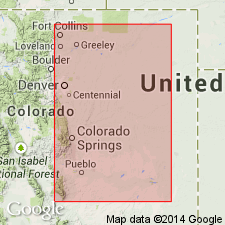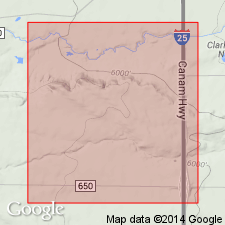
- Usage in publication:
-
- Apache sandstone member
- Modifications:
-
- Areal extent
- Dominant lithology:
-
- Sandstone
- AAPG geologic province:
-
- Las Vegas-Raton basin
Summary:
Pg. 399. Apache sandstone. In Walsenburg district, eastern Colorado, the basal zone of Pierre shale contains a 20-foot sandstone member which H.W.C. Prommel in an unpublished report has called Apache sandstone. Age is Late Cretaceous.
Source: US geologic names lexicon (USGS Bull. 896, p. 60).
- Usage in publication:
-
- Apache Creek sandstone member
- Modifications:
-
- Areal extent
- AAPG geologic province:
-
- Las Vegas-Raton basin
Mitchell, J.M., Greene, John, and Gould, D.B., 1956, Catalog of stratigraphic names used in the Raton basin and vicinity, [Colorado-New Mexico]: Rocky Mountain Association of Geologists Field Conference Guidebook, p. 131-135.
Summary:
Pg. 131. Listed in catalog of stratigraphic names as Apache Creek sandstone member of Pierre shale. [Age is Late Cretaceous.]
Source: US geologic names lexicon (USGS Bull. 1200, p. 115-116).

- Usage in publication:
-
- Apache Creek Sandstone Member*
- Modifications:
-
- Reference
- Dominant lithology:
-
- Shale
- Sandstone
- AAPG geologic province:
-
- Las Vegas-Raton basin
Summary:
Designated a member of Pierre Shale. Lies between transition member (below) and Sharon Springs Member (above). Original description did not designate a type. Purpose of report is to redefine, establish stratigraphic boundaries, designate and describe a reference section [written prior to inclusion of principal reference section as a formal procedure], and discuss age, fossils, and correlation. Reference section designated and measured on west-facing valley wall on east side of valley tributary to North Apache Creek, SE1/4 sec 30, T25S, R67W, Huerfano Co, CO in Las Vegas-Raton basin. A section 82 ft 7 in thick composed of yellow-gray sandstone that may be shaly and concretionary, gray sandy shale, ironstone concretion beds, and brown platy, iron-stained siltstone. Is 200 ft thick at Pueblo. Contains ammonites. Correlated with Menefee Formation, Sussex Sandstone Member of Cody Shale, and with upper part of Gammon Ferruginous Member of Pierre Shale. Is of very early late Campanian, Late Cretaceous age. Correlation chart.
Source: GNU records (USGS DDS-6; Denver GNULEX).
For more information, please contact Nancy Stamm, Geologic Names Committee Secretary.
Asterisk (*) indicates published by U.S. Geological Survey authors.
"No current usage" (†) implies that a name has been abandoned or has fallen into disuse. Former usage and, if known, replacement name given in parentheses ( ).
Slash (/) indicates name conflicts with nomenclatural guidelines (CSN, 1933; ACSN, 1961, 1970; NACSN, 1983, 2005, 2021). May be explained within brackets ([ ]).

